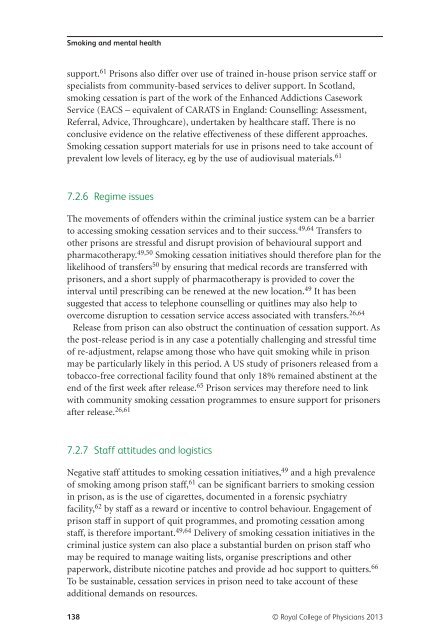Smoking and mental health - NCSCT
Smoking and mental health - NCSCT
Smoking and mental health - NCSCT
Create successful ePaper yourself
Turn your PDF publications into a flip-book with our unique Google optimized e-Paper software.
<strong>Smoking</strong> <strong>and</strong> <strong>mental</strong> <strong>health</strong><br />
support. 61 Prisons also differ over use of trained in-house prison service staff or<br />
specialists from community-based services to deliver support. In Scotl<strong>and</strong>,<br />
smoking cessation is part of the work of the Enhanced Addictions Casework<br />
Service (EACS – equivalent of CARATS in Engl<strong>and</strong>: Counselling: Assessment,<br />
Referral, Advice, Throughcare), undertaken by <strong>health</strong>care staff. There is no<br />
conclusive evidence on the relative effectiveness of these different approaches.<br />
<strong>Smoking</strong> cessation support materials for use in prisons need to take account of<br />
prevalent low levels of literacy, eg by the use of audiovisual materials. 61<br />
7.2.6 Regime issues<br />
The movements of offenders within the criminal justice system can be a barrier<br />
to accessing smoking cessation services <strong>and</strong> to their success. 49,64 Transfers to<br />
other prisons are stressful <strong>and</strong> disrupt provision of behavioural support <strong>and</strong><br />
pharmacotherapy. 49,50 <strong>Smoking</strong> cessation initiatives should therefore plan for the<br />
likelihood of transfers 50 by ensuring that medical records are transferred with<br />
prisoners, <strong>and</strong> a short supply of pharmacotherapy is provided to cover the<br />
interval until prescribing can be renewed at the new location. 49 It has been<br />
suggested that access to telephone counselling or quitlines may also help to<br />
overcome disruption to cessation service access associated with transfers. 26,64<br />
Release from prison can also obstruct the continuation of cessation support. As<br />
the post-release period is in any case a potentially challenging <strong>and</strong> stressful time<br />
of re-adjustment, relapse among those who have quit smoking while in prison<br />
may be particularly likely in this period. A US study of prisoners released from a<br />
tobacco-free correctional facility found that only 18% remained abstinent at the<br />
end of the first week after release. 65 Prison services may therefore need to link<br />
with community smoking cessation programmes to ensure support for prisoners<br />
after release. 26,61<br />
7.2.7 Staff attitudes <strong>and</strong> logistics<br />
Negative staff attitudes to smoking cessation initiatives, 49 <strong>and</strong> a high prevalence<br />
of smoking among prison staff, 61 can be significant barriers to smoking cession<br />
in prison, as is the use of cigarettes, documented in a forensic psychiatry<br />
facility, 62 by staff as a reward or incentive to control behaviour. Engagement of<br />
prison staff in support of quit programmes, <strong>and</strong> promoting cessation among<br />
staff, is therefore important. 49,64 Delivery of smoking cessation initiatives in the<br />
criminal justice system can also place a substantial burden on prison staff who<br />
may be required to manage waiting lists, organise prescriptions <strong>and</strong> other<br />
paperwork, distribute nicotine patches <strong>and</strong> provide ad hoc support to quitters. 66<br />
To be sustainable, cessation services in prison need to take account of these<br />
additional dem<strong>and</strong>s on resources.<br />
138 © Royal College of Physicians 2013














